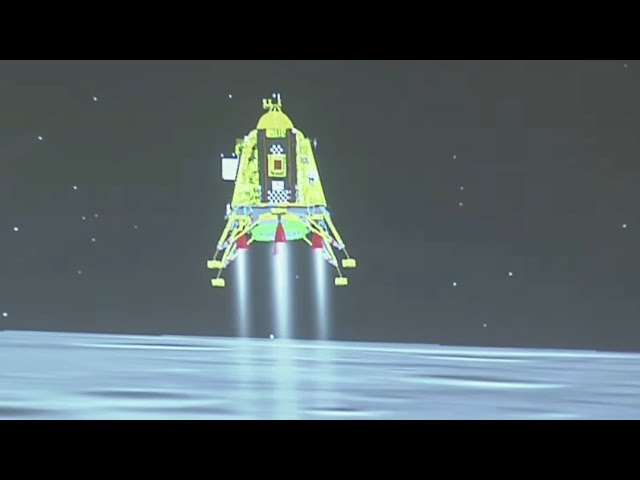
A video grab of Vikram lander module of Chandrayaan-3 spacecraft approaching the Moon's south polar region.
(By Ritu Mousumi Tripathy)
Date: 23/08/2023
Time: 1804 IST
India creates history!
Chandrayaan-3 – the country’s third mission to Moon achieves ‘precise-perfect’ landing on the Lunar South Pole. India’s quest to become a space superpower receives a massive momentum with this landmark expedition which would be etched in golden letters.
Just over a week after the Nation celebrated its 77th Independence Day, Chandrayaan-3 – the crucial follow-on mission to Chandrayaan-2 spearheaded by Indian Space Research Organisation (ISRO) – carved its historic footprint on the Lunar surface.
With this incredible feat, India became the FIRST country in the world to touch down on a “yet-to-be-explored” south polar region of the Moon believed to be a treasure-trove of icy water and other vital minerals. India also became only the fourth country in the world to achieve a soft landing on the Moon’s surface after the US, the former Soviet Union and China. Chandrayaan-3 – the crucial follow-on mission to Chandrayaan-2 mission undertaken by ISRO – was being watched over by the entire world with bated breath.
India’s audacious voyage to Moon which started on July 14 became all the more exciting soon after Russian space agency Roscosmos launched its Luna-25 spacecraft much later on August 10 to attempt a similar soft-landing on the Lunar South Pole. However, Luna-25 crash landed on the lunar surface on August 20, ending the Russian mission therein.
India’s Chandrayaan-3, meanwhile, continued its smooth sailing towards its destination. The 2019 Chandrayaan-2 mission had successfully placed an orbiter around the Moon, but could not soft-land the ‘Vikram’ module on the Lunar South Pole.
A Landmark Journey Begins With Billion Hopes & Prayers
Carrying a billion hopes and prayers of every proud Indian, Chandrayaan-3 embarked on its historic journey towards the Moon on July 14. ISRO’s indigenously-built LVM3-M4 (previously GSLV Mk-III) heavy-lift rocket carrying the nearly 3,896-kg spacecraft launched successfully from the Satish Dhawan Space Centre at Sriharikota, Andhra Pradesh, at 1435 IST.
“14th July 2023 will always be etched in golden letters as far as India’s space sector is concerned. Chandrayaan-3, our third lunar mission will embark on its journey,” Prime Minister Narendra Modi said in a Twitter (now X) message ahead of the historic launch.
ISRO Chairman S. Somanath too offered his prayers ahead of the critical launch which involved an excellent team of Indian space scientists and technocrats who put in their best efforts and left no stone unturned to make the highly coveted mission a grand success for the Nation.
As India landed on the Moon, PM Modi remarked: “This is an unforgettable moment...an unprecedented moment. This moment is the victory cry of a developed India.”
Smooth Sailing Towards The Moon
ISRO conducted five orbit raising manoeuvres between July 15 and July 25 before inserting the spacecraft in trans-lunar orbit on August 1 by undertaking the crucial “slingshot move” which sent Chandrayaan-3 towards the Moon. The spacecraft escaped from orbiting the Earth and began following a path that would take it to the vicinity of the Moon.
On August 5, Chandrayaan-3 was successfully inserted into the lunar orbit. “The orbit achieved was 164 km x 18074 km, as intended,” ISRO announced. With the successful Lunar Orbit Insertion (LOI), Chandrayaan-3 sent incredible images of the Moon and its craters while inching closer towards its destination.
Post LOI, ISRO carried out a series of orbit reduction manoeuvres on the spacecraft between August 6 and 16. On August 17, the Lander Module (‘Vikram’) of Chandrayaan-3 successfully separated from the Propulsion Module.
On August 18, ISRO conducted first de-boosting operation to reduce the orbit of the lander to 113 km x 157 km. The second and final de-boosting operation was carried out two days later on August 20 to further reduce the lander module’s orbit to 25 km x 134 km. With this critical operation passing by smoothly, scientists at ISRO looked buoyant and confident to achieve a precision soft-landing of Vikram lander on the lunar South Pole on August 23.
Conquering A 'Never-Touched-Before' Frontier
The Vikram lander module touched down in a picture-perfect manner at the Lunar South Pole precisely at 1804 hours IST, as planned by ISRO. With this unique space odyssey, the Indian space agency conquered a new frontier and elevated India’s space programme to glorious heights. The Chandrayaan-3 became a hallmark of India’s brilliance in rocket science and a finest testimony of the country’s mastery over highly advanced, sophisticated technologies involving astronautics.
The race to Moon has been quite frantic of late with many countries attempting lunar landing in the last few years. Previously, Israel and Japan have attempted to land their unmanned spacecraft on the Moon, but without success.
While Israeli spacecraft ‘Beresheet’, launched as the country’s “first privately funded lunar mission” in February 2019, crashed just moments before it was to land on the Moon, a similar attempt by a Japanese private entity, ispace inc, also ended in failure after the spacecraft lost contact with the lander which unexpectedly accelerated and possibly crashed onto the lunar surface. Russia’s Luna-25 moon mission, undertaken after a gap of nearly 50 years, also met with similar fate.
Diligently Enduring ‘15 Minutes of Terror’
Making a soft landing on the Moon’s surface was fraught with several challenges. The final “15-minutes of terror” involved many intricate manoeuvres such as velocity reduction of the Lander, its re-orientation from horizontal to vertical position, retro-firing of engines to give reverse thrust for a smooth descend.
At an altitude of 25 km to 30 km, the lunar Lander was in a horizontal position. “Transferring it from horizontal orientation to vertical one is the biggest challenge – as similar to the one faced during Chanrayaan-2 mission,” the ISRO Chairman Dr. S. Somanath had explained earlier. The process of reducing the velocity of the lander from 30 km height to the final landing, and the ability to reorient the spacecraft from horizontal to vertical direction would be the trickiest part, he had said.
To ensure a glitch-free landing, at around 30 km altitude, the lander entered the crucial “powered braking phase”, and started using its four thruster engines by “retro firing” them to reach the Moon’s surface, by gradually reducing the speed. On reaching an altitude of around 6.8 km, only two engines were used, while two others were shut down, aimed at giving reverse thrust to the lander as it descended further.
Additionally, ISRO had outlined a large area for the lunar landing and also loaded the craft with more fuel. All these ensured a grand success for the mission.
Chandrayaan-2: The ‘Stepping Stone’ to Success
Mission Chandrayaan-2, launched in September 2019 with the objective to soft-land a probe on lunar South Pole, became a “stepping stone” for its follow-on mission – Chandrayaan-3. Although it failed to place the ‘Vikram’ lander (bearing same name as that of Chandrayaan-3’s) on the lunar surface, Chandrayaan-2 could successfully place an orbiter around the Moon. In fact, due to the precise launch and orbital manoeuvres, the mission life of the Chandrayaan-2 orbiter increased to seven years, as per ISRO.
Even as Chandrayaan-3 was preparing to soft-land on the far-side of Moon, its Lander Module ‘Vikram’ became successful in establishing contact with its predecessor’s orbiter. ISRO on August 21 confirmed that ‘two-way communication’ between the (Chandrayaan-2) orbiter and (Chandryaan-3) lander module had been established.
Meanwhile, the Chandrayaan-2 orbiter provided some crucial help, including an image captured by it, for better identification of landing locations on the Moon. ISRO had gained some deep insights in its previous attempt during Chandrayaan-2 which ultimately paved way for Chandrayaan-3 to come out triumphant!
“The knowledge we had on Chandrayaan-2, we have used here (in Chandrayaan-3 mission)”, ISRO Chairman S Somanath had said.
The third Moon mission of India, launched after a gap of nearly four years, gave enough time to ISRO scientists to make robust preparations to ensure the mission achieves its maximum objectives.
India Carves its Footprint on Moon
Chandrayaan-3 has finally carved India’s footprint on the Moon. After etching India’s footprint on the lunar soil, the Vikram lander successfully deployed the six-wheeled Pragyan rover which stepped out of the lander belly.
“The Ch-3 Rover ramped down from the Lander and India took a walk on the Moon," said ISRO.
During their two-week lunar sojourn, the Vikram lander and Pragyan rover would conduct in-situ scientific experiments. Pragyan will leave imprints of the ISRO and India’s national emblem – the Lion Capital of Ashoka at Sarnath – on the lunar surface. India’s historic expedition to the lunar South Pole would thus remain imprinted on Moon’s soil.
The Pragyan rover, with its two payloads ‘APXS’ and ‘LIBS’, will carry out in-situ chemical analysis of the lunar surface during the course of its mobility.
Payloads of Vikram Lander
• Chandra’s Surface Thermophysical Experiment (ChaSTE) to measure thermal conductivity and temperature
• Instrument for Lunar Seismic Activity (ILSA) for measuring the seismicity around the landing site
• Langmuir Probe (LP) to estimate the plasma density and its variations
The lander is also carrying the passive Laser Retroreflector Array from NASA for lunar laser ranging studies.
Payloads of Pragyan Rover
• Alpha Particle X-ray Spectrometer (APXS) &
• Laser Induced Breakdown Spectroscope (LIBS) for deriving the elemental composition in the vicinity of landing site.
Mission Lifespan: 1 Moon Day (14 Earth Days)
Mission objectives:
• To demonstrate Safe and Soft Landing on Lunar Surface
• To demonstrate Rover roving on the Moon
• To conduct in-situ scientific experiments
Synergy between Public & Private Sector Space Entities
With this historic Moon mission, India witnessed brilliant synergy of efforts among some of its public and private sector space and aerospace entities. While ISRO led the mission from front, a number of public and private sector firms of the country contributed in making the mission a rousing success.
Some of these entities include Larsen and Toubro (L&T) which provided several crucial components for the spacecraft, including the booster segments, ground and flight umbilical plates etc. It also played a role in system integration of the launch vehicle.
Godrej Aerospace supplied liquid propulsion engines such as Vikas and satellite thrusters. Hindustan Aeronautics Ltd. (HAL) gave many important components to National Aerospace Laboratories (NAL) for Chandrayaan-3 mission. Likewise, Tata Steel manufactured the crane used for launching the LVM3-M4 rocket. Many other industry partners of ISRO gave their full support to the mission.
Exploring Moon’s ‘Mysterious Side’
The lunar south pole remains unexplored for several reasons. Its treacherous terrains, extreme weather conditions and huge craters extending many miles make it challenging. According to NASA, at the lunar South Pole, the Sun hovers below or just above the horizon, creating temperatures upwards of 54° C during sunlit periods. Even during these periods of illumination, soaring mountains cast dark shadows and deep craters protect perpetual darkness in their abysses. Some of these craters are home to permanently shadowed regions that haven’t seen sunlight in billions of years and experience temperatures as low as -203° C.
Such “deep, dark” craters on the lunar south pole could therefore possibly contain water ice and other ‘volatiles’ dating from early Solar System, believe space scientists. The region’s unique characteristics hold promise for unprecedented deep space scientific discoveries.
Future Ahead
Recent lunar missions undertaken by several countries have failed to touch down successfully on the Moon’s surface. The last one to do so was China’s Change-5 spacecraft which landed on the Moon on December 1, 2020.
With the huge success coming in India’s way, the country has taken a clear and decisive lead in conquering the Moon’s so-far unexplored region. As days pass by, and scientists at ISRO gather more and more important data pertaining to the Moon’s South Pole region, Chandrayaan-3 is certainly going to open up newer vistas, not just for India, but for the entire world in its future voyages to the Moon and beyond.
As space scientists plan future expeditions to the Moon and even intend to make the Moon ‘a permanent base’ for deep-space explorations, India’s Chandrayaan-3 would remain a key “pathbreaker” in humanity’s forward journey to explore the Universe.
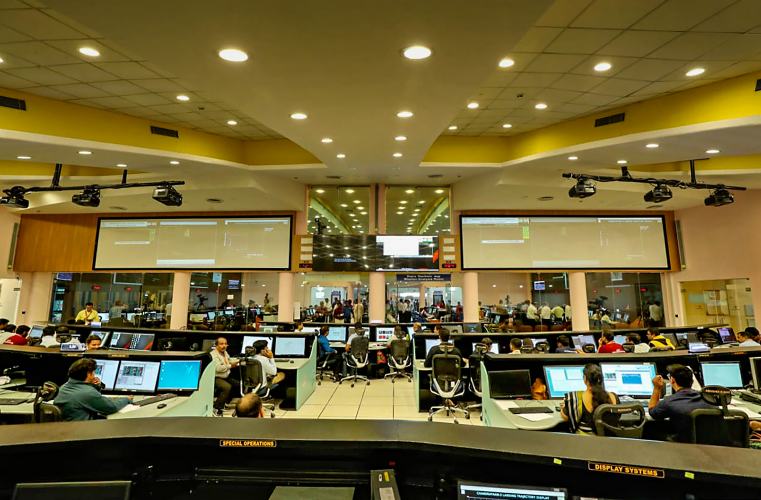 Previous Article
Previous Article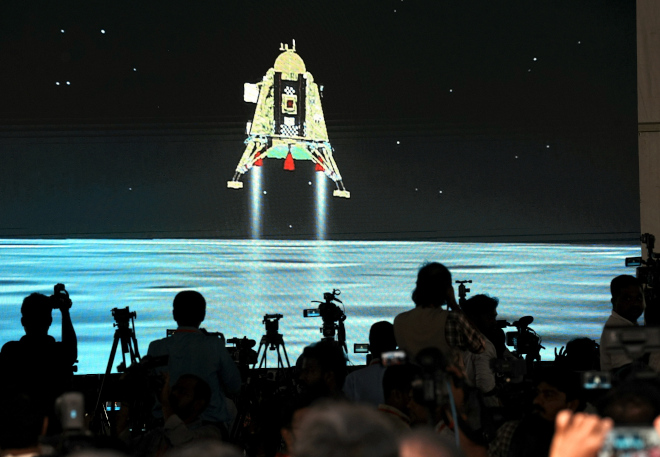 Next Article
Next Article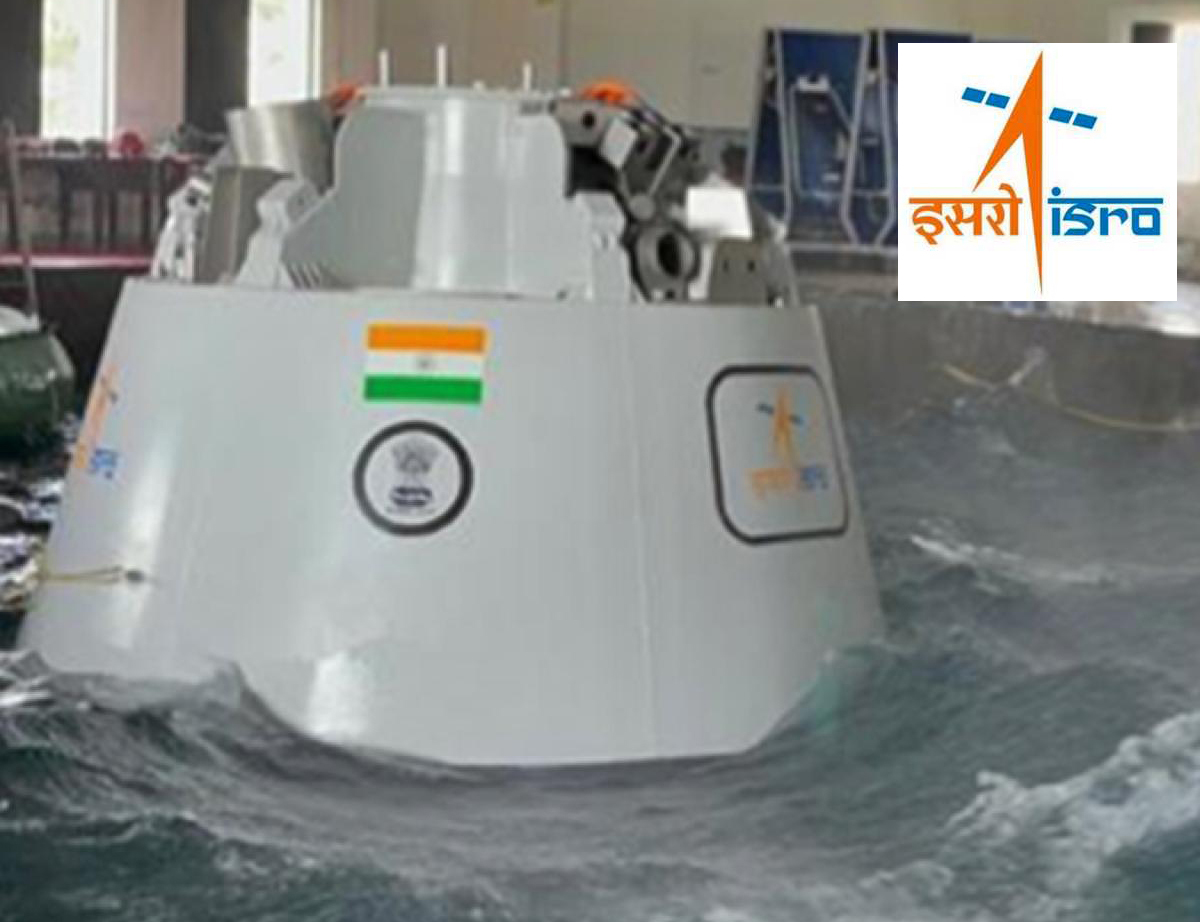
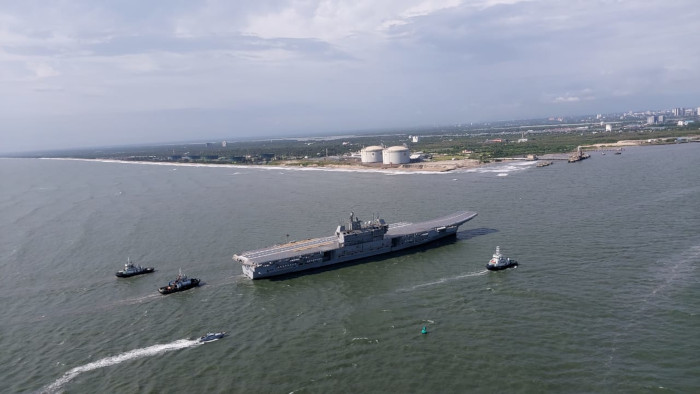

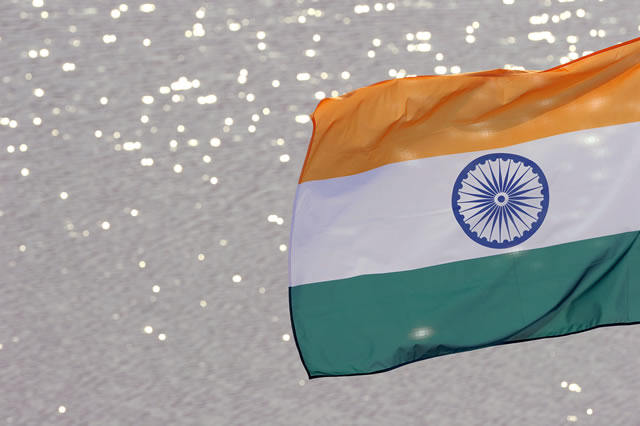









The Indian Air Force, in its flight trials evaluation report submitted before the Defence Ministry l..
view articleAn insight into the Medium Multi-Role Combat Aircraft competition...
view articleSky enthusiasts can now spot the International Space Station (ISS) commanded by Indian-American astr..
view article